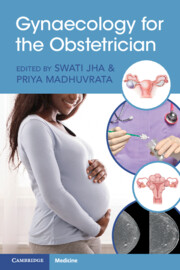Book contents
- Gynaecology for the Obstetrician
- Gynaecology for the Obstetrician
- Copyright page
- Dedication
- Contents
- Contributors
- Foreword
- Preface
- Chapter 1 Ovarian Cysts in Pregnancy
- Chapter 2 Fibroids in Pregnancy
- Chapter 3 Cervical Abnormalities in Pregnancy
- Chapter 4 Vulval Disorders in Pregnancy
- Chapter 5 Congenital Uterine Malformations and Vaginal Anomalies
- Chapter 6 Vaginal Prolapse and Previous Prolapse Surgery
- Chapter 7 Urinary Tract Problems in Pregnancy
- Chapter 8 Previous Third and Fourth Degree Tears
- Chapter 9 Management of Post-Partum Retained Placental Remnants
- Chapter 10 Gestational Trophoblastic Disease (GTD)
- Chapter 11 Female Genital Mutilation
- Chapter 12 Ovarian and Cervical Malignancy in Pregnancy
- Chapter 13 Post-Partum Contraception
- Chapter 14 Pregnancy Associated Breast Cancer
- Index
- References
Chapter 9 - Management of Post-Partum Retained Placental Remnants
Published online by Cambridge University Press: 14 July 2023
- Gynaecology for the Obstetrician
- Gynaecology for the Obstetrician
- Copyright page
- Dedication
- Contents
- Contributors
- Foreword
- Preface
- Chapter 1 Ovarian Cysts in Pregnancy
- Chapter 2 Fibroids in Pregnancy
- Chapter 3 Cervical Abnormalities in Pregnancy
- Chapter 4 Vulval Disorders in Pregnancy
- Chapter 5 Congenital Uterine Malformations and Vaginal Anomalies
- Chapter 6 Vaginal Prolapse and Previous Prolapse Surgery
- Chapter 7 Urinary Tract Problems in Pregnancy
- Chapter 8 Previous Third and Fourth Degree Tears
- Chapter 9 Management of Post-Partum Retained Placental Remnants
- Chapter 10 Gestational Trophoblastic Disease (GTD)
- Chapter 11 Female Genital Mutilation
- Chapter 12 Ovarian and Cervical Malignancy in Pregnancy
- Chapter 13 Post-Partum Contraception
- Chapter 14 Pregnancy Associated Breast Cancer
- Index
- References
Summary
Placental remnants following birth are often heralded by secondary post-partum haemorrhage. Diagnosis is assisted by an ultrasound scan, with MRI indicated when the scan is inconclusive. Emergency measures are required for excessive bleeding. A conservative approach is appropriate when bleeding is not heavy. Confirmation of intra-uterine placental tissue by repeated scans ensures surgery is confined to women with a high chance of retained tissue. Traditional curettage is often replaced by hysteroscopic resection allowing direct and precise removal of placental remnants with less trauma to adjacent normal endometrium. Hysteroscopic treatment, under general anaesthetic or as an outpatient, is preferably deferred for 2–3 months after delivery to minimise complications, without compromising longer-term outcomes like fertility or subsequent pregnancy rates. Intra-uterine adhesions may occur especially following repeated blind curettage, which can compromise future fertility. Clear communication with the patient and partner is important. Further research into the management options for postdelivery placental remnants is required to ascertain best practice.
Keywords
- Type
- Chapter
- Information
- Gynaecology for the Obstetrician , pp. 83 - 94Publisher: Cambridge University PressPrint publication year: 2023



